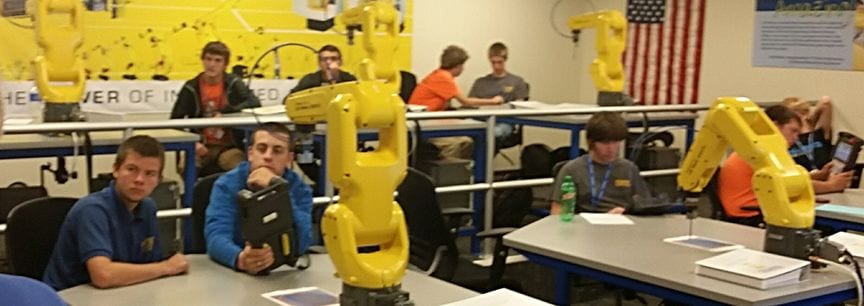Robotics Industries Association features Tri-Rivers RAMTEC
Robotics Industries Association (ria) features Tri-Rivers RAMTEC in their Robotics Online.
Robotics Software for the Next Generation
by Tanya M. Anandan, Contributing Editor
Robotic Industries Association Posted 09/29/2016
The days of robots as dim-witted devices are gone. The future is filled with smart sensors, software and EOAT. For it’s the brain behind the brawn. The puppeteer pulling the strings. The escape from relentless monotony. Without software, brilliant hardware goes nowhere.
But software can’t do it alone. Those robot “brains” are an extension of human capability. A reflection of our vision for what’s possible. Visions that get keener with every generation and every technological leap. Sophisticated software and intelligent robotics depend on us, on our evolution.
At the Tri-Rivers Career Center in Marion, Ohio, home of the Robotic Advanced Manufacturing Technical Education Collaborative (RAMTEC), students of all ages are preparing for their future. A future populated with intelligent machines and connected systems.
“It’s important that kids start understanding the concept of robotics,” says Ritch Ramey, RAMTEC Engineering Coordinator. “We’re going to see it expand probably tenfold in the use of robots over the next 15 to 20 years. They should at least know the basics of robotics.”
According to the International Federation of Robotics, global robot deployment will more than double from 1 million in 2009 to 2.3 million robots by 2018. To keep those robots humming, and evolving, we will need a skilled workforce on a scale not seen in history. A tall order that requires Closing the Skills Gap in Automation: A Call for Action. RAMTEC is answering the call.
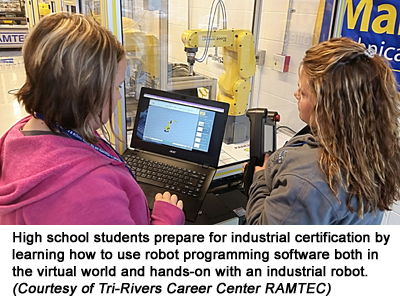
Learning how to program robots, and the ins and outs of various software platforms, is an integral part of the curriculum at RAMTEC. Students learn how to use robots made by FANUC, Yaskawa Motoman and Universal Robots. They also learn robotic welding, PLCs, hydraulics, pneumatics, CNCs, computer-aided design, and even 3D printing, the necessary building blocks for any budding engineer or robotics technician.
Ramey, a credentialed instructor at RAMTEC, says they plan to add machine vision to their robotics curriculum, as vision guided robotics has become essential to many industrial applications. With Industry 4.0 coming and the Industrial Internet of Things (IIOT) vital to the smart factory concept, he says RAMTEC’s students will also need to learn the Cisco platform as they enter an ever-connected industrial world.
RAMTEC instructors have credentials to teach on both FANUC and Yaskawa industrial robotic platforms. They also recently added the Universal Robots collaborative robot to the curriculum at Tri-Rivers. Ramey hopes to soon add more types of collaborative robots to the program.
“With both FANUC and Motoman, we get trained at their facilities and then they have additional training for instructors to credential their students in industrial robotics,” explains Ramey. “The instructor has to go through special training beyond the industry four-day training and 30 hours of e-learning.”
Robotics Coordinator Mark Edington was named a finalist for National ACTE Postsecondary Teacher of the Year after being awarded the honor at the regional level. Credentialed on both FANUC and Yaskawa platforms, Edington came out of retirement three years ago and since then has trained nearly 250 students and many of his fellow instructors. He is one of five finalists for the 2017 national title, which will be announced in November.
The RAMTEC sites, nine in all across Ohio, provide students with the software training required for the following credentials:
- FANUC Handling Tool Operation and Programming certification
- Yaskawa Motoman DX100 Basic Programming certification
- Certified SOLIDWORKS Associate
- AutoCAD Certified Professional
“Our students have to do exactly what the industry people do,” says Ramey. “The same amount of time, same assignments, same e-learning, and same tests to get their credentialing.”
The students are typically high school juniors and seniors, such as Christina Irvine and Brianna Pritchard seen learning how to use FANUC’s ROBOGUIDE robot simulation software. The students are comparing the software menu on the PC used in their e-learning courses to the actual robot in the FANUC Certified Education Robot Training (CERT) Cart. This type of virtual and hands-on training prepares the students for FANUC certification.
FANUC recently introduced a fenceless version of its Cert Cart. Check out this video.
“We teach offline programming, because that’s a real tool,” says Ramey. “You can’t just stop a production line to program a robot. A lot of the programming is done on the virtual software, either ROBOGUIDE or MotoSim (Yaskawa’s simulation software).”
Hands-On Robot Training
FANUC and Yaskawa each have their own system languages inherent with the robot controllers. FANUC has its TP (teach pendant) programming language and Yaskawa has INFORM.
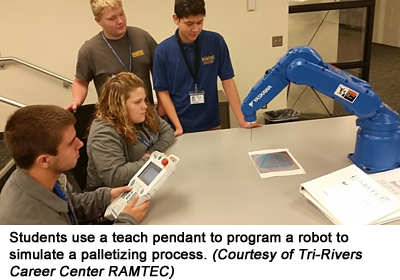 “I don’t think there’s an advantage to either robot programming language,” says Ramey. “Whichever one the students learn first is a little harder because it’s a brand new concept. But once the students learn one programming language, they pick up the next one much faster.”
“I don’t think there’s an advantage to either robot programming language,” says Ramey. “Whichever one the students learn first is a little harder because it’s a brand new concept. But once the students learn one programming language, they pick up the next one much faster.”
As pictured, high school junior Wesley Stillions uses a teach pendant to program a Yaskawa Motoman robot to simulate a palletizing process as fellow students Brianna Pritchard, Jordan Bush and Jaylin Tyler observe the demonstration.
At RAMTEC the student-robot ratio is typically 2:1 or 3:1, so students get significant hands-on time with the robot cell. The students learn welding and palletizing processes not only using the mobile education carts, but also using large payload robots.
“With a lot of schools, they will have maybe 10 of the software virtual packages and maybe one industrial robot, so they will program on the virtual robot,” explains Ramey. “Then they take that program on a pendant and plug it into the robot and it will run. You can also have the virtual pendant on the computer, but the real training is that (hardware) teach pendant that controls everything.”
For educational environments with limited resources, Yaskawa offers the MotoSIM Touch Simulation Tool, which is a PC-based offline programming environment and robotics simulation tool that provides instructors and students with a “real world” virtual robotics experience at a fraction of the cost of purchasing an industrial robot.
“We also have virtual software, but at our facility the students are primarily working on robots,” says Ramey. “Everything is on a teach pendant.”
Robot Programming Wish List
Ramey says he hopes to see the robot teach pendants get smaller, more like a PlayStation controller, and much easier to use. “Down the road, I see them going to even your basic cell phone and tablet to program robots.”
He would also like a feature that he saw at the recent IMTS show to become widespread: “Where you can just drag the end effector or end of the robot around and put your position points where you want them, and then it will remember those, instead of using XYZ coordinates and all the jogging coordinates. That will make things so much simpler. You can actually go in and grab the robot, show it what you want it to do and then tweak the program. That needs to become universal in all robots.
“A must is being able to plug the teach pendant right into the robot,” he adds, versus using a flash drive to transfer a program to the robot.
“I think the next generation of software will be able to reach a younger generation of students,” says Ramey. “I think all of industry is looking at how to get more high school and junior high students involved. Schools are also pushing robotics down to the elementary level. The next wave of students will be more robot savvy than this generation, because years of experience and terminology will help them learn faster. Industry might have to catch up with the kids at that point.”
RAMTEC is hosting an event to celebrate Manufacturing Day on October 13, including a facility tour, a VEX Robotics Competition, and for the first time, an industrial robotics contest. Ramey says students are thirsting for more real-world robotics applications experience. He hopes the industrial robotics contest will become a national competition.
End users of automation and robotics often use these types of events for scouting new recruits. Ramey notes that at their National Robotics Challenge in April, industry partner Honda hired more than 15 RAMTEC students.
Thanks to grants by the Ohio Department of Education, the RAMTEC concept will be thriving in 23 locations by fall 2017. A larger pool of students will have opportunities for career development in advanced manufacturing and robotics, a big push towards tightening that skills gap.
In other parts of the world, they’re taking training on the road. Check out this first-of-its-kind mobile training center for robotics in Brazil.
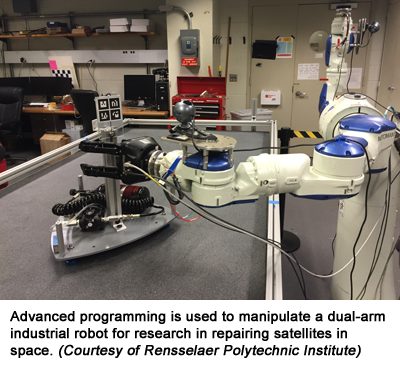 Robotics University
Robotics University
Along the banks of the Hudson River, students here are also readying themselves for a future in advanced manufacturing. Glenn Saunders is helping prepare the next generation of engineers and roboticists for the age of the intelligent factory. As Senior Research Engineer in the Center for Automation Technologies and Systems (CATS) at Rensselaer Polytechnic Institute in Troy, New York, he conducts applied research with an industry focus in robotics, automation and manufacturing. The research work Saunders and his undergrad and graduate students conduct is often motivated by a company with a specific need and usually falls into two areas.
“We like to say that we do research ‘in’ robotics and we do research ‘with’ robots,” explains Saunders. “The research ‘in’ robotics is generally where we’re developing robots or we’re developing very research-like applications with industrial robots. Whereas in research ‘with’ robots we don’t mess with the native controller and we use all the tools that are available to the industrial customer. That’s really looking at a specific application for a robot, as opposed to trying to do new and interesting things with a robot.”
Rensselaer researchers and students have a wide range of robotics platforms to work with. This includes a small Stäubli RX40 robot, two Adept Cobra robots, a Mitsubishi arm, a Yaskawa Motoman SDA dual-arm robot, three Baxter collaborative robots, a Universal Robots UR5 cobot, and a Barrett WAM arm.
“With the Adept robots, we’re using the Adept programming software and Adept vision software pretty much right out of the box,” says Saunders. “That’s a case where we’re trying to discover whether or not we can solve a manufacturing problem with an industrial arm, versus reaching out into a whole new area where an industrial arm may not have been used before.”
“For instance with the Yaskawa dual-arm, we’re using their high-speed controller and interfacing with it at a much lower level than the typical industrial customer,” says Saunders. “But it’s still an industrial robot. So in that case we’re making the robot system more intelligent.
“We’re issuing commands directly to the robot controller without using the teach pendant,” explains Saunders, noting that this requires a deeper understanding of software programming than is typically used in the industrial world.
Advanced Software Programming for Outer Space
And where better than an out-of-this-world application? Saunders and his students are working with NASA’s Goddard Space Flight Center to explore the use of an industrial robot arm to repair satellites in space.
“These are satellites that have been in space for years, or decades in some cases, and they’ve reached their design life,” says Saunders. “The question is whether or not you can actually service these satellites in space, which were never designed to be serviced at all, and get some additional life out of this very expensive asset, versus launching a whole new satellite.”
The Yaskawa dual-arm robot (pictured) is equipped with a Robotiq 3-Finger Adaptive Gripper and an ATI Force/Torque Sensor. A webcam is mounted on the arm that is used for tracking the space object. A visual tag provides position/orientation information to the robot.
“We are doing things like force control where we put a force sensor on the arm. The motion of the robot is in response to the forces that we’re experiencing at the force torque sensor, versus just point-to-point motion,” explains Saunders. “That’s both in the realm of research and industry, specifically force control. But we do it a little differently, because we need to simulate a zero-gravity condition (as in space).”
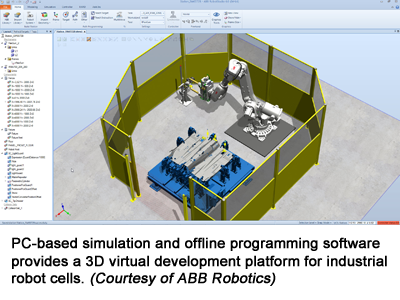 Simulation Software on Campus
Simulation Software on Campus
Saunders says in many cases they just use the native programming that comes with the robot. That’s the case with their latest acquisition, an ABB Robotics IRB 6640 robot, which uses ABB’s RAPID programming language.
ABB also provided Rensselaer with 100 seats of its RobotStudio simulation and offline programming software (screenshot), making it available to all the students on campus.
“That was a big part of our decision to make a purchase through ABB,” says Saunders. “All of our students will have access to it (RobotStudio) and we’re very grateful for that.”
Advanced offline programming and simulation software has been put to some unique tasks. Watch robotic sculpting using OCTOPUZ software in this customer spotlight.
Saunders says he’s very impressed with the software capabilities available within the industrial space. He cites one example where Rensselaer helped a company source an industrial robot.
“We have an external device, a press, and it will be ejecting a part along a certain vector, and so the robot needs to be able to access that load along that vector. We got quotes from four suppliers and every single one said, ‘Yep, we have a solution for that, it’s readily available.’ That surprised us. We thought it was going to be difficult, but everybody already had a solution. We were impressed with the sophistication of the industrial software.”
Open-Source Software
On the more “researchy” side, as Saunders refers to it, a lot of what Rensselaer does is in ROS, an open-source robot operating system that recently celebrated its eight-year anniversary.
“We use ROS and we contribute to the open source community within ROS,” says Saunders. “The learning curve is quite steep. There are powerful capabilities, but certainly not easy to use. Young people that are comfortable around a computer and the Linux operating system pick it up more easily.
“Both the Baxter (Rethink Robotics) and UR (Universal Robots) are based in large part on ROS,” continues Saunders. “ROS has a lot of different software capabilities and one of them is visualization (Gazebo robot simulation). It includes software that does things like path planning. The software will come up with a way to move the arm from point A to point B without crashing into things in the work envelope. It also includes software for mobile bases, which is beyond most of the industrial robots.”
Rethink’s Baxter robot comes in an industrial version and a research version. Saunders says the difference is entirely in the software. “The Baxter Research Robot basically gives you access to a lot of the lower level functions that you would not normally have access to as an industrial customer.”
Rensselaer researchers accessed those ROS-based lower level functions to develop a mobile in-home assistance robot. Watch Baxter on Wheels (BOW) in action.
Most of the university’s applications for ROS open-source software have been on the purely research side. Still, Rensselaer is looking to the future with membership in the ROS-Industrial Consortium, which extends the advanced capabilities of ROS to manufacturing automation and robotics.
“We operate in the industrial space. That’s why it was important for us to be members of the ROS-I Consortium,” says Saunders. “We’re full members and have been for three years.
“Part of our mission is to help industry, and in particular New York state industry, to be more competitive,” he continues. “In order for us to do our jobs we need to be in a position where we can advise our industrial clients on what’s coming down the road. We see ROS-I as having a pretty big impact on the capabilities of industrial robots and therefore the capabilities of our industrial partners. It’s really us looking forward.”
Saunders says membership in the consortium provides insight into how the open-source software is used in research and various applications around the industrial world. Big names such as 3M, BMW, Boeing, Caterpillar, Ford, John Deere and Siemens are members. Check out this video montage of ROS-I from its third birthday.
Other consortium members in the educational and research community such as the University of Texas at Austin, Nuclear and Applied Robotics Group, are exploring novel teleoperation applications that could be used for remote hazardous sites. Watch ROS-I in action as this robot gets some help threading a needle.
“We go to the meetings and we see the work that’s being done within the consortium at the other industrial facilities or industrial partners and that gives us a way to bring that information back to the companies that we work with,” says Saunders at Rensselaer. “The primary benefit is being connected to the community.”
Keeping industry connected with the educational community will help bridge the skills gap. Preparing our current and future workforce for automation and robotics will span that divide.
RIA Members featured in this article:
ABB Robotics
Rensselaer Polytechnic Institute
Tri-Rivers Career Center RAMTEC

